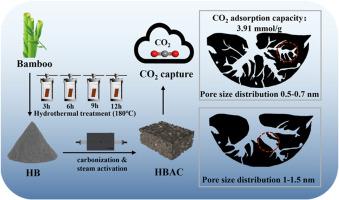Hydrothermal pretreatment for controlling bamboo biomass composition and regulating pore structure of bamboo-based activated carbon for CO2 adsorption
IF 6.2
2区 工程技术
Q2 ENERGY & FUELS
引用次数: 0
Abstract
Activated carbon with a narrow distribution of ultra micropores is regarded as a promising CO2 adsorbent. Although chemical activation increases ultra microporosity, it entails high cost, equipment corrosion, and limited scalability. In this study bamboo was used as the precursor, and hydrothermal pretreatment was introduced prior to carbonization and steam activation to regulate the 0.5–0.7 nm pore-size distribution by adjusting the cellulose/lignin ratio. Biomass composition analysis together with N2/CO2 adsorption measurements was employed to establish the composition-structure-performance linkage. Results show that the sample derived from bamboo hydrothermally pretreated at 180 °C for 6 h, is featured with abundant micropores, with a distribution centered at 0.5–0.7 nm and a specific surface area of 1025 m2/g, achieving a CO2 adsorption capacity of 3.91 mmol/g at 273 K and 1 bar. Overall, this work demonstrates a scalable, reagent-free physical-activation pathway that regulates the narrow distribution of ultra micropores, delivering CO2 adsorbents suitable for energy and industrial systems.

水热预处理控制竹生物量组成及调节竹基活性炭孔结构对CO2的吸附
活性炭具有较窄的超微孔分布,是一种很有前途的CO2吸附剂。虽然化学活化增加了超微孔隙度,但成本高,设备腐蚀,可扩展性有限。本研究以竹子为前驱体,在炭化和蒸汽活化前引入水热预处理,通过调节纤维素/木质素比调节0.5 ~ 0.7 nm的孔径分布。通过生物量组成分析和N2/CO2吸附测定,建立了组分-结构-性能的联系。结果表明,经180℃水热预处理6 h的竹材样品具有丰富的微孔,微孔以0.5 ~ 0.7 nm为中心分布,比表面积为1025 m2/g,在273 K、1 bar条件下吸附CO2的容量为3.91 mmol/g。总的来说,这项工作证明了一种可扩展的、无试剂的物理激活途径,可以调节超微孔的狭窄分布,提供适合能源和工业系统的二氧化碳吸附剂。
本文章由计算机程序翻译,如有差异,请以英文原文为准。
求助全文
约1分钟内获得全文
求助全文
来源期刊

Journal of The Energy Institute
工程技术-能源与燃料
CiteScore
10.60
自引率
5.30%
发文量
166
审稿时长
16 days
期刊介绍:
The Journal of the Energy Institute provides peer reviewed coverage of original high quality research on energy, engineering and technology.The coverage is broad and the main areas of interest include:
Combustion engineering and associated technologies; process heating; power generation; engines and propulsion; emissions and environmental pollution control; clean coal technologies; carbon abatement technologies
Emissions and environmental pollution control; safety and hazards;
Clean coal technologies; carbon abatement technologies, including carbon capture and storage, CCS;
Petroleum engineering and fuel quality, including storage and transport
Alternative energy sources; biomass utilisation and biomass conversion technologies; energy from waste, incineration and recycling
Energy conversion, energy recovery and energy efficiency; space heating, fuel cells, heat pumps and cooling systems
Energy storage
The journal''s coverage reflects changes in energy technology that result from the transition to more efficient energy production and end use together with reduced carbon emission.
 求助内容:
求助内容: 应助结果提醒方式:
应助结果提醒方式:


